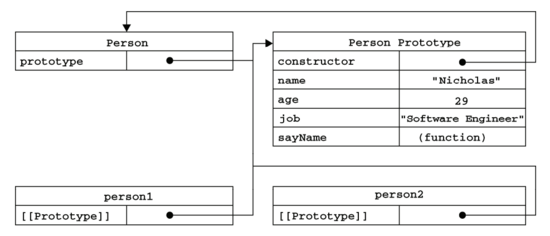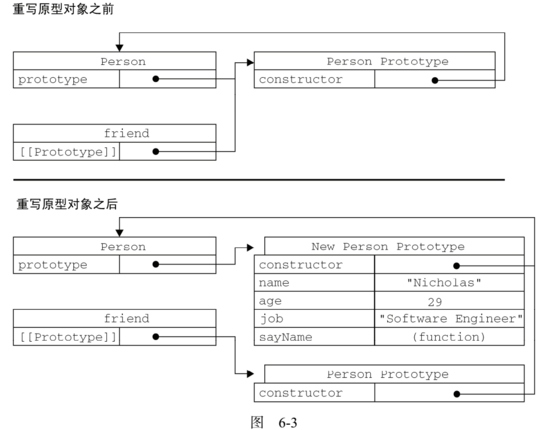жӮЁеҘҪпјҢзҷ»еҪ•еҗҺжүҚиғҪдёӢи®ўеҚ•е“ҰпјҒ
еңЁе·ҘдҪңдёӯжңүж—¶еҖҷдјҡзңӢеҲ°prototypeе’Ң__proto__иҝҷдёӨдёӘеұһжҖ§пјҢеҜ№иҝҷдёӨдёӘеұһжҖ§жҲ‘дёҖзӣҙжҜ”иҫғи’ҷеңҲпјҢдҪҶжҳҜжҲ‘йҖҡиҝҮжҹҘйҳ…зӣёе…іиө„ж–ҷпјҢеҶіе®ҡеҒҡдёҖдёӢжҖ»з»“еҠ ж·ұиҮӘе·ұзҡ„зҗҶи§ЈпјҢеҶҷеҫ—дёҚеҜ№зҡ„ең°ж–№иҝҳиҜ·еҗ„дҪҚеӨ§зҘһжҢҮеҮәгҖӮ
1гҖҒprototype
жҜҸдёӘеҮҪж•°йғҪжңүдёҖдёӘprototypeеұһжҖ§пјҢиҜҘеұһжҖ§жҳҜдёҖдёӘжҢҮй’ҲпјҢжҢҮеҗ‘дёҖдёӘеҜ№иұЎгҖӮ иҖҢиҝҷдёӘеҜ№иұЎзҡ„з”ЁйҖ”жҳҜеҢ…еҗ«з”ұзү№е®ҡзұ»еһӢзҡ„жүҖжңүе®һдҫӢе…ұдә«зҡ„еұһжҖ§е’Ңж–№жі•гҖӮдҪҝз”ЁиҝҷдёӘеҜ№иұЎзҡ„еҘҪеӨ„е°ұжҳҜеҸҜд»Ҙи®©жүҖжңүе®һдҫӢеҜ№иұЎе…ұдә«е®ғжүҖжӢҘжңүзҡ„еұһжҖ§е’Ңж–№жі•
2гҖҒ __proto__
жҜҸдёӘе®һдҫӢеҜ№иұЎйғҪжңүдёҖдёӘ__proto__еұһжҖ§пјҢз”ЁдәҺжҢҮеҗ‘жһ„йҖ еҮҪж•°зҡ„еҺҹеһӢеҜ№иұЎгҖӮ__proto__еұһжҖ§жҳҜеңЁи°ғз”Ёжһ„йҖ еҮҪж•°еҲӣе»әе®һдҫӢеҜ№иұЎж—¶дә§з”ҹзҡ„гҖӮ
function Person(name, age, job){
this.name = name;
this.age = age;
this.job = job;
this.sayName = function(){
console.log(this.name);
}; // дёҺеЈ°жҳҺеҮҪж•°еңЁйҖ»иҫ‘дёҠжҳҜзӯүд»·зҡ„
}
var person1=new Person("Nicholas",29,"Software Engineer");
console.log(person1);
console.log(Person);
console.log(person1.prototype);//undefined
console.log(person1.__proto__);
console.log(Person.prototype);
console.log(person1.__proto__===Person.prototype);//true
иҫ“еҮәз»“жһңеҰӮдёӢпјҡ

жҖ»з»“пјҡ
1гҖҒи°ғз”Ёжһ„йҖ еҮҪж•°еҲӣе»әзҡ„е®һдҫӢеҜ№иұЎзҡ„prototypeеұһжҖ§дёә"undefined",жһ„йҖ еҮҪж•°зҡ„prototypeжҳҜдёҖдёӘеҜ№иұЎгҖӮ
2гҖҒ__proto__еұһжҖ§жҳҜеңЁи°ғз”Ёжһ„йҖ еҮҪж•°еҲӣе»әе®һдҫӢеҜ№иұЎж—¶дә§з”ҹзҡ„гҖӮ
3гҖҒи°ғз”Ёжһ„йҖ еҮҪж•°еҲӣе»әзҡ„е®һдҫӢеҜ№иұЎзҡ„__proto__еұһжҖ§жҢҮеҗ‘жһ„йҖ еҮҪж•°зҡ„prototypeгҖӮ
4гҖҒеңЁй»ҳи®Өжғ…еҶөдёӢпјҢжүҖжңүеҺҹеһӢеҜ№иұЎйғҪдјҡиҮӘеҠЁиҺ·еҫ—дёҖдёӘconstructor(жһ„йҖ еҮҪж•°)еұһжҖ§пјҢиҝҷдёӘеұһжҖ§еҢ…еҗ«дёҖдёӘжҢҮеҗ‘prototypeеұһжҖ§жүҖеңЁеҮҪж•°зҡ„жҢҮй’ҲгҖӮ
дёӢеӣҫеұ•зӨәдәҶдҪҝз”ЁPersonжһ„йҖ еҮҪж•°еҲӣе»әе®һдҫӢеҗҺеҗ„дёӘеҜ№иұЎд№Ӣй—ҙзҡ„е…ізі»

дёҠеӣҫеұ•зӨәдәҶ Person жһ„йҖ еҮҪж•°гҖҒ Person зҡ„еҺҹеһӢеұһжҖ§д»ҘеҸҠ PersonзҺ°жңүзҡ„дёӨдёӘе®һдҫӢд№Ӣй—ҙзҡ„е…ізі»гҖӮ
3гҖҒ и·ҹ__proto__еұһжҖ§зӣёе…ізҡ„дёӨдёӘж–№жі•
isPrototypeOf():иҷҪ然еңЁжүҖжңүе®һзҺ°дёӯйғҪж— жі•и®ҝй—®еҲ°__proto__пјҢдҪҶеҸҜд»ҘйҖҡиҝҮ isPrototypeOf()ж–№жі•жқҘзЎ®е®ҡеҜ№иұЎд№Ӣй—ҙжҳҜеҗҰеӯҳеңЁиҝҷз§Қе…ізі»гҖӮ
alert(Person.prototype.isPrototypeOf(person1)); //true alert(Person.prototype.isPrototypeOf(person2)); //true
Object.getPrototypeOf():еңЁжүҖжңүж”ҜжҢҒзҡ„е®һзҺ°дёӯпјҢиҝҷдёӘж–№жі•иҝ”еӣһ__proto__зҡ„еҖјгҖӮдҫӢеҰӮпјҡ
alert(Object.getPrototypeOf(person1) == Person.prototype); //true alert(Object.getPrototypeOf(person1).name); //"Nicholas"
жіЁж„ҸпјҡиҷҪ然еҸҜд»ҘйҖҡиҝҮеҜ№иұЎе®һдҫӢи®ҝй—®дҝқеӯҳеңЁеҺҹеһӢдёӯзҡ„еҖјпјҢдҪҶеҚҙдёҚиғҪйҖҡиҝҮеҜ№иұЎе®һдҫӢйҮҚеҶҷеҺҹеһӢдёӯзҡ„еҖјгҖӮеҰӮжһңжҲ‘们еңЁе®һдҫӢдёӯж·»еҠ дәҶдёҖдёӘеұһжҖ§пјҢиҖҢиҜҘеұһжҖ§дёҺе®һдҫӢеҺҹеһӢдёӯзҡ„дёҖдёӘеұһжҖ§еҗҢеҗҚпјҢйӮЈжҲ‘们е°ұеңЁе®һдҫӢдёӯеҲӣе»әиҜҘеұһжҖ§пјҢиҜҘеұһжҖ§е°ҶдјҡеұҸи”ҪеҺҹеһӢдёӯзҡ„йӮЈдёӘеұһжҖ§гҖӮиҜ·зңӢдёӢйқўзҡ„дҫӢеӯҗпјҡ
function Person(){
}
Person.prototype.name = "Nicholas";
Person.prototype.age = 29;
Person.prototype.job = "Software Engineer";
Person.prototype.sayName = function(){
alert(this.name);
};
var person1 = new Person();
var person2 = new Person();
person1.name = "Greg";
alert(person1.name); //"Greg"вҖ”вҖ” жқҘиҮӘе®һдҫӢ
alert(person2.name); //"Nicholas"вҖ”вҖ” жқҘиҮӘеҺҹеһӢ
4гҖҒ еҲӨж–ӯеұһжҖ§жҳҜеӯҳеңЁе®һдҫӢеҜ№иұЎдёӯпјҢиҝҳжҳҜеӯҳеңЁеҺҹеһӢеҜ№иұЎдёӯпјҢжңүд»ҘдёӢж–№жі•
hasOwnProperty():еҸҜд»ҘжЈҖжөӢдёҖдёӘеұһжҖ§жҳҜеӯҳеңЁдәҺе®һдҫӢдёӯпјҢиҝҳжҳҜеӯҳеңЁдәҺеҺҹеһӢдёӯгҖӮиҝ”еӣһеҖјдёәtrueиЎЁзӨәиҜҘеұһжҖ§еӯҳеңЁе®һдҫӢеҜ№иұЎдёӯпјҢе…¶д»–жғ…еҶөйғҪдёәfalseгҖӮ
in ж“ҚдҪңз¬Ұ:ж— и®әиҜҘеұһжҖ§еӯҳеңЁдәҺе®һдҫӢдёӯиҝҳжҳҜеҺҹеһӢдёӯгҖӮеҸӘиҰҒеӯҳеңЁеҜ№иұЎдёӯпјҢйғҪдјҡиҝ”еӣһtrueгҖӮдҪҶжҳҜеҸҜд»ҘеҗҢж—¶дҪҝз”Ё hasOwnProperty()ж–№жі•е’Ң in ж“ҚдҪңз¬ҰпјҢе°ұеҸҜд»ҘзЎ®е®ҡиҜҘеұһжҖ§еҲ°еә•жҳҜеӯҳеңЁдәҺеҜ№иұЎдёӯпјҢиҝҳжҳҜеӯҳеңЁдәҺеҺҹеһӢдёӯгҖӮ
var person1 = new Person();
var person2 = new Person();
alert(person1.hasOwnProperty("name")); //false
alert("name" in person1); //true
person1.name = "Greg";
alert(person1.name); //"Greg" вҖ”вҖ” жқҘиҮӘе®һдҫӢ
alert(person1.hasOwnProperty("name")); //true
alert("name" in person1); //true
alert(person2.name); //"Nicholas" вҖ”вҖ” жқҘиҮӘеҺҹеһӢ
alert(person2.hasOwnProperty("name")); //false
alert("name" in person2); //true
delete person1.name;
alert(person1.name); //"Nicholas" вҖ”вҖ” жқҘиҮӘеҺҹеһӢ
alert(person1.hasOwnProperty("name")); //false
alert("name" in person1); //true
5гҖҒ иҺ·еҸ–жҲ–йҒҚеҺҶеҜ№иұЎдёӯеұһжҖ§зҡ„еҮ з§Қж–№жі•
for-inпјҡйҖҡиҝҮfor-inеҫӘзҺҜзҡ„иҝ”еӣһзҡ„жҳҜиғҪеӨҹиў«и®ҝй—®зҡ„гҖҒеҸҜжһҡдёҫзҡ„еұһжҖ§пјҢдёҚз®ЎиҜҘеұһжҖ§жҳҜеңЁе®һдҫӢдёӯпјҢиҝҳжҳҜеӯҳеңЁеҺҹеһӢдёӯгҖӮ
function Person(name, age, job) {
this.name = name;
this.age = age;
this.job = job;
}
Person.prototype={
sayName:function(){
return this.name;
}
}
var p=new Person("жқҺжҳҺ",30,"иҜ—дәә");
for(var prop in p){
console.log(prop);//nameгҖҒageгҖҒjobгҖҒsayName
}
console.log(Object.keys(p));//["name", "age", "job"]
console.log(Object.keys(Person.prototype));//["sayName"]
console.log(Object.getOwnPropertyNames(Person.prototype))
// ["constructor", "sayName"]
Object.keys()пјҡеҸ–еҫ—е®һдҫӢеҜ№иұЎдёҠжүҖжңүеҸҜжһҡдёҫзҡ„еұһжҖ§гҖӮ Object.getOwnPropertyNames(): иҺ·еҸ–е®һдҫӢеҜ№иұЎжүҖжңүеұһжҖ§пјҢж— и®әе®ғжҳҜеҗҰеҸҜжһҡдёҫгҖӮ
жіЁж„ҸпјҡдҪҝз”ЁеҜ№иұЎеӯ—йқўйҮҸжқҘйҮҚеҶҷж•ҙдёӘеҺҹеһӢеҜ№иұЎж—¶пјҢжң¬иҙЁдёҠе®Ңе…ЁйҮҚеҶҷдәҶй»ҳи®Өзҡ„ prototype еҜ№иұЎпјҢеӣ жӯӨ constructor еұһжҖ§д№ҹе°ұеҸҳжҲҗдәҶж–°еҜ№иұЎзҡ„ constructor еұһжҖ§пјҲжҢҮеҗ‘ Object жһ„йҖ еҮҪж•°пјүпјҢдёҚеҶҚжҢҮеҗ‘ PersonгҖӮдҪҶжҳҜеҸҜд»ҘйҖҡиҝҮеңЁйҮҚеҶҷеҺҹеһӢеҜ№иұЎж—¶жҢҮе®ҡconstructorеұһжҖ§пјҢдҪҝд№ӢиҝҳжҳҜжҢҮеҗ‘еҺҹжқҘзҡ„constructorгҖӮжӯӨж—¶пјҢе°Ҫз®Ў instanceof ж“ҚдҪңз¬ҰиҝҳиғҪиҝ”еӣһжӯЈзЎ®зҡ„з»“жһңпјҢдҪҶйҖҡиҝҮ constructor е·Із»Ҹж— жі•зЎ®е®ҡеҜ№иұЎзҡ„зұ»еһӢдәҶгҖӮ
object instanceof constructor:жЈҖжөӢ constructor.prototype жҳҜеҗҰеӯҳеңЁдәҺеҸӮж•° object зҡ„еҺҹеһӢй“ҫдёҠгҖӮ
function Person() {}
var friend2 = new Person();
Person.prototype = {
//constructor : Person,
name: "Nicholas",
age: 29,
job: "Software Engineer",
sayName: function() {
alert(this.name);
}
};
var friend = new Person();
console.log(friend2 instanceof Object); //true
console.log(friend2 instanceof Person); //false,
console.log(friend2.constructor == Person); //true
console.log(friend2.constructor == Object); //false
console.log(friend instanceof Object); //true
console.log(friend instanceof Person); //true
console.log(friend.constructor == Person); //false
console.log(friend.constructor == Object); //true
з”ұдәҺеҺҹеһӢзҡ„еҠЁжҖҒжҖ§пјҢи°ғз”Ёжһ„йҖ еҮҪж•°ж—¶дјҡдёәе®һдҫӢж·»еҠ дёҖдёӘжҢҮеҗ‘жңҖеҲқеҺҹеһӢзҡ„PrototypeжҢҮй’ҲпјҢиҖҢжҠҠеҺҹеһӢдҝ®ж”№дёәеҸҰеӨ–дёҖдёӘеҜ№иұЎе°ұзӯүдәҺеҲҮж–ӯдәҶжһ„йҖ еҮҪж•°дёҺжңҖеҲқеҺҹеһӢд№Ӣй—ҙзҡ„иҒ”зі»гҖӮзңӢдёӢйқўзҡ„дҫӢеӯҗ
function Person(){
}
var friend = new Person();
Person.prototype = {
constructor: Person,
name : "Nicholas",
age : 29,
job : "Software Engineer",
sayName : function () {
alert(this.name);
}
};
var friend2=new Person();
friend.sayName(); //Uncaught TypeError: friend.sayName is not a function
friend2.sayName();//Nicholas
console.log(friend instanceof Person);//false
console.log(friend instanceof Object);//true
console.log(friend2 instanceof Person);//true
з»“жһңеҲҶжһҗпјҡиҝҷжҳҜеӣ дёәfriend1зҡ„prototypeжҢҮеҗ‘зҡ„жҳҜжІЎйҮҚеҶҷPerson.prototypeд№ӢеүҚзҡ„Person.prototypeпјҢд№ҹе°ұжҳҜжһ„йҖ еҮҪж•°жңҖеҲқзҡ„еҺҹеһӢеҜ№иұЎгҖӮиҖҢfriend2зҡ„prototypeжҢҮеҗ‘зҡ„жҳҜйҮҚеҶҷPerson.prototypeеҗҺзҡ„Person.prototypeгҖӮеҰӮдёӢеӣҫжүҖзӨә

6гҖҒ еҺҹеһӢй“ҫ
еҹәжң¬жҖқжғіжҳҜеҲ©з”ЁеҺҹеһӢи®©дёҖдёӘеј•з”Ёзұ»еһӢ继жүҝеҸҰдёҖдёӘеј•з”Ёзұ»еһӢзҡ„еұһжҖ§е’Ңж–№жі•гҖӮжңҖзӣҙи§Ӯзҡ„иЎЁзҺ°е°ұжҳҜи®©еҺҹеһӢеҜ№иұЎзӯүдәҺеҸҰдёҖдёӘзұ»еһӢзҡ„е®һдҫӢгҖӮ
function SuperType(){
this.property = true;
}
SuperType.prototype.getSuperValue = function(){
return this.property;
};
function SubType(){
this.subproperty = false;
}
//继жүҝдәҶ SuperType
SubType.prototype = new SuperType();
SubType.prototype.getSubValue = function (){
return this.subproperty;
};
var instance = new SubType();
alert(instance.getSuperValue()); //true
SubType.prototype = new SuperType();иҝҷеҸҘд»Јз ҒдҪҝеҫ—еҺҹжқҘеӯҳеңЁдәҺ SuperType зҡ„е®һдҫӢдёӯзҡ„жүҖжңүеұһжҖ§е’Ңж–№жі•пјҢзҺ°еңЁд№ҹеӯҳеңЁдәҺ SubType.prototype дёӯгҖӮдҪҝеҫ—instanceзҡ„constructorжҢҮеҗ‘дәҶSuperTypeгҖӮ
console.log(instance.constructor===SuperType);//true
жҖ»з»“пјҡ и®ҝй—®дёҖдёӘе®һдҫӢеұһжҖ§ж—¶пјҢйҰ–е…ҲдјҡеңЁе®һдҫӢдёӯжҗңзҙўиҜҘеұһжҖ§гҖӮеҰӮжһңжІЎжңүжүҫеҲ°иҜҘеұһжҖ§пјҢеҲҷдјҡ继з»ӯжҗңзҙўе®һдҫӢзҡ„еҺҹеһӢгҖӮеңЁйҖҡиҝҮеҺҹеһӢй“ҫе®һзҺ°з»§жүҝзҡ„жғ…еҶөдёӢпјҢжҗңзҙўиҝҮзЁӢе°ұеҫ—д»ҘжІҝзқҖеҺҹеһӢй“ҫ继з»ӯеҗ‘дёҠгҖӮеңЁжүҫдёҚеҲ°еұһжҖ§жҲ–ж–№жі•зҡ„жғ…еҶөдёӢпјҢжҗңзҙўиҝҮзЁӢжҖ»жҳҜиҰҒдёҖзҺҜдёҖзҺҜең°еүҚиЎҢеҲ°еҺҹеһӢй“ҫжң«з«ҜжүҚдјҡеҒңдёӢжқҘгҖӮ
е°ұжӢҝдёҠйқўзҡ„дҫӢеӯҗжқҘиҜҙпјҢи°ғз”Ё instance.getSuperValue()дјҡз»ҸеҺҶ4дёӘжҗңзҙўжӯҘйӘӨпјҡ
д»ҘдёҠе°ұжҳҜжң¬ж–Үзҡ„е…ЁйғЁеҶ…е®№пјҢеёҢжңӣеҜ№еӨ§е®¶зҡ„еӯҰд№ жңүжүҖеё®еҠ©пјҢд№ҹеёҢжңӣеӨ§е®¶еӨҡеӨҡж”ҜжҢҒдәҝйҖҹдә‘гҖӮ
е…ҚиҙЈеЈ°жҳҺпјҡжң¬з«ҷеҸ‘еёғзҡ„еҶ…е®№пјҲеӣҫзүҮгҖҒи§Ҷйў‘е’Ңж–Үеӯ—пјүд»ҘеҺҹеҲӣгҖҒиҪ¬иҪҪе’ҢеҲҶдә«дёәдё»пјҢж–Үз« и§ӮзӮ№дёҚд»ЈиЎЁжң¬зҪ‘з«ҷз«ӢеңәпјҢеҰӮжһңж¶үеҸҠдҫөжқғиҜ·иҒ”зі»з«ҷй•ҝйӮ®з®ұпјҡis@yisu.comиҝӣиЎҢдёҫжҠҘпјҢ并жҸҗдҫӣзӣёе…іиҜҒжҚ®пјҢдёҖз»ҸжҹҘе®һпјҢе°Ҷз«ӢеҲ»еҲ йҷӨж¶үе«ҢдҫөжқғеҶ…е®№гҖӮ
жӮЁеҘҪпјҢзҷ»еҪ•еҗҺжүҚиғҪдёӢи®ўеҚ•е“ҰпјҒ